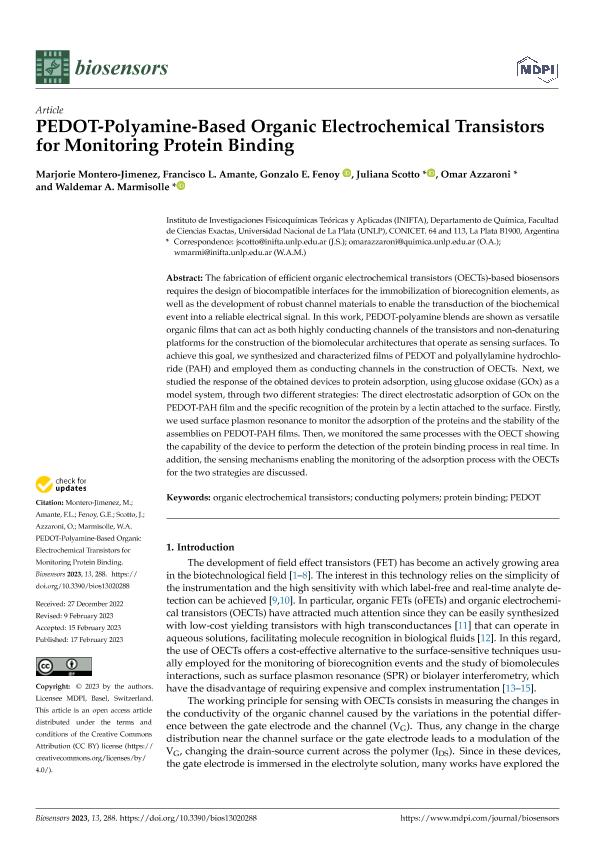Mostrar el registro sencillo del ítem
dc.contributor.author
Montero Jiménez, Marjorie Elizabeth

dc.contributor.author
Amante, Francisco L.
dc.contributor.author
Fenoy, Gonzalo Eduardo

dc.contributor.author
Scotto, Juliana

dc.contributor.author
Azzaroni, Omar

dc.contributor.author
Marmisollé, Waldemar Alejandro

dc.date.available
2024-02-16T15:17:47Z
dc.date.issued
2023-02
dc.identifier.citation
Montero Jiménez, Marjorie Elizabeth; Amante, Francisco L.; Fenoy, Gonzalo Eduardo; Scotto, Juliana; Azzaroni, Omar; et al.; PEDOT-Polyamine-Based Organic Electrochemical Transistors for Monitoring Protein Binding; MDPI; Biosensors; 13; 2; 2-2023; 1-15
dc.identifier.issn
2079-6374
dc.identifier.uri
http://hdl.handle.net/11336/227279
dc.description.abstract
The fabrication of efficient organic electrochemical transistors (OECTs)-based biosensors requires the design of biocompatible interfaces for the immobilization of biorecognition elements, as well as the development of robust channel materials to enable the transduction of the biochemical event into a reliable electrical signal. In this work, PEDOT-polyamine blends are shown as versatile organic films that can act as both highly conducting channels of the transistors and non-denaturing platforms for the construction of the biomolecular architectures that operate as sensing surfaces. To achieve this goal, we synthesized and characterized films of PEDOT and polyallylamine hydrochloride (PAH) and employed them as conducting channels in the construction of OECTs. Next, we studied the response of the obtained devices to protein adsorption, using glucose oxidase (GOx) as a model system, through two different strategies: The direct electrostatic adsorption of GOx on the PEDOT-PAH film and the specific recognition of the protein by a lectin attached to the surface. Firstly, we used surface plasmon resonance to monitor the adsorption of the proteins and the stability of the assemblies on PEDOT-PAH films. Then, we monitored the same processes with the OECT showing the capability of the device to perform the detection of the protein binding process in real time. In addition, the sensing mechanisms enabling the monitoring of the adsorption process with the OECTs for the two strategies are discussed.
dc.format
application/pdf
dc.language.iso
eng
dc.publisher
MDPI
dc.rights
info:eu-repo/semantics/openAccess
dc.rights.uri
https://creativecommons.org/licenses/by/2.5/ar/
dc.subject
CONDUCTING POLYMERS
dc.subject
ORGANIC ELECTROCHEMICAL TRANSISTORS
dc.subject
PEDOT
dc.subject
PROTEIN BINDING
dc.subject.classification
Química Analítica

dc.subject.classification
Ciencias Químicas

dc.subject.classification
CIENCIAS NATURALES Y EXACTAS

dc.title
PEDOT-Polyamine-Based Organic Electrochemical Transistors for Monitoring Protein Binding
dc.type
info:eu-repo/semantics/article
dc.type
info:ar-repo/semantics/artículo
dc.type
info:eu-repo/semantics/publishedVersion
dc.date.updated
2024-02-14T12:48:13Z
dc.journal.volume
13
dc.journal.number
2
dc.journal.pagination
1-15
dc.journal.pais
Suiza

dc.description.fil
Fil: Montero Jiménez, Marjorie Elizabeth. Consejo Nacional de Investigaciones Científicas y Técnicas. Centro Científico Tecnológico Conicet - La Plata. Instituto de Investigaciones Fisicoquímicas Teóricas y Aplicadas. Universidad Nacional de La Plata. Facultad de Ciencias Exactas. Instituto de Investigaciones Fisicoquímicas Teóricas y Aplicadas; Argentina
dc.description.fil
Fil: Amante, Francisco L.. Consejo Nacional de Investigaciones Científicas y Técnicas. Centro Científico Tecnológico Conicet - La Plata. Instituto de Investigaciones Fisicoquímicas Teóricas y Aplicadas. Universidad Nacional de La Plata. Facultad de Ciencias Exactas. Instituto de Investigaciones Fisicoquímicas Teóricas y Aplicadas; Argentina
dc.description.fil
Fil: Fenoy, Gonzalo Eduardo. Consejo Nacional de Investigaciones Científicas y Técnicas. Centro Científico Tecnológico Conicet - La Plata. Instituto de Investigaciones Fisicoquímicas Teóricas y Aplicadas. Universidad Nacional de La Plata. Facultad de Ciencias Exactas. Instituto de Investigaciones Fisicoquímicas Teóricas y Aplicadas; Argentina
dc.description.fil
Fil: Scotto, Juliana. Consejo Nacional de Investigaciones Científicas y Técnicas. Centro Científico Tecnológico Conicet - La Plata. Instituto de Investigaciones Fisicoquímicas Teóricas y Aplicadas. Universidad Nacional de La Plata. Facultad de Ciencias Exactas. Instituto de Investigaciones Fisicoquímicas Teóricas y Aplicadas; Argentina
dc.description.fil
Fil: Azzaroni, Omar. Consejo Nacional de Investigaciones Científicas y Técnicas. Centro Científico Tecnológico Conicet - La Plata. Instituto de Investigaciones Fisicoquímicas Teóricas y Aplicadas. Universidad Nacional de La Plata. Facultad de Ciencias Exactas. Instituto de Investigaciones Fisicoquímicas Teóricas y Aplicadas; Argentina
dc.description.fil
Fil: Marmisollé, Waldemar Alejandro. Consejo Nacional de Investigaciones Científicas y Técnicas. Centro Científico Tecnológico Conicet - La Plata. Instituto de Investigaciones Fisicoquímicas Teóricas y Aplicadas. Universidad Nacional de La Plata. Facultad de Ciencias Exactas. Instituto de Investigaciones Fisicoquímicas Teóricas y Aplicadas; Argentina
dc.journal.title
Biosensors
dc.relation.alternativeid
info:eu-repo/semantics/altIdentifier/url/https://www.mdpi.com/2079-6374/13/2/288
dc.relation.alternativeid
info:eu-repo/semantics/altIdentifier/doi/http://dx.doi.org/10.3390/bios13020288
Archivos asociados
